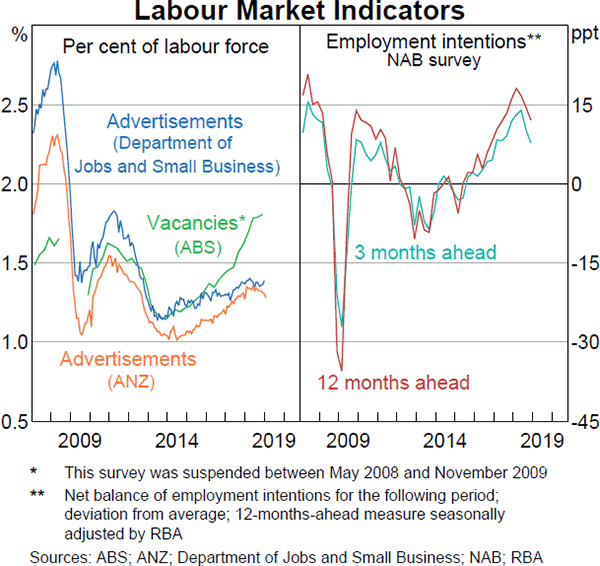Statement on Monetary Policy – February 2019 2. Domestic Economic Conditions
Conditions in the domestic economy continue to be supported by low interest rates and growth in the global economy. Australian economic growth was low in the September quarter, but looks to have been firmer more recently and remains a bit above potential growth in year-ended terms. Surveyed business conditions have declined from high levels to be closer to average, and households' sentiment towards their own finances has remained relatively resilient to falls in housing prices. Employment growth remains strong and the unemployment rate declined further to be around 5 per cent in late 2018.
| September quarter 2018 |
June quarter 2018 |
Year to September quarter 2018 |
|
|---|---|---|---|
| GDP | 0.3 | 0.9 | 2.8 |
| Domestic final demand | 0.3 | 0.7 | 2.7 |
| – Consumption | 0.3 | 0.9 | 2.5 |
| – Dwelling investment | 1.0 | 1.9 | 7.1 |
| – Mining investment | −7.5 | 6.5 | −13.6 |
| – Non-mining investment | −0.1 | −2.0 | 3.6 |
| – Public consumption | 0.5 | 0.9 | 4.8 |
| – Public investment | 5.1 | −1.1 | 3.5 |
| Change in inventories(a) | −0.3 | 0.1 | 0.1 |
| Exports | 0.1 | 1.2 | 4.1 |
| Imports | −1.5 | 0.5 | 1.5 |
| Mining activity(b) | −3.0 | 2.6 | 3.7 |
| Non-mining activity(b) | 0.7 | 0.6 | 2.6 |
| Farm GDP | −0.9 | 1.0 | −8.1 |
| Non-farm GDP | 0.3 | 0.9 | 3.0 |
| Nominal GDP | 1.0 | 1.1 | 5.2 |
| Terms of trade | 0.8 | −1.1 | 2.7 |
|
(a) Contribution to GDP growth Sources: ABS; RBA |
|||
Growth in economic activity is a little above trend
GDP growth in the September quarter eased to 0.3 per cent following two quarters of strong growth (Table 2.1; Graph 2.1). Information from surveys, the Bank's business liaison program and labour market indicators suggest that there was a bit more momentum in domestic demand than implied by the September quarter data. Year-ended growth in the economy remains a bit above estimates of potential growth. Domestic final demand grew by 2.7 per cent over the year, with positive contributions from most components.
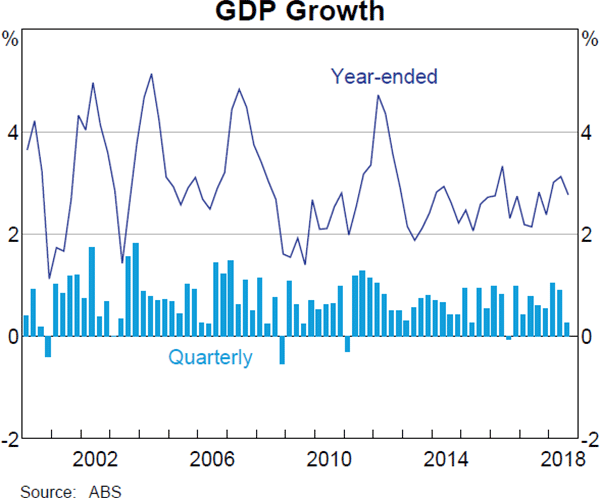
Non-mining business investment has moderated, but indicators generally remain positive
Private non-mining business investment was little changed in the September quarter, but grew by 3½ per cent over the year (Graph 2.2). Growth over the year was led by non-residential construction activity, which includes buildings and infrastructure-related projects. The rapid pace of building activity seen over 2017/18 has moderated recently for most building types, while private sector spending on infrastructure-related projects remains elevated, supported by electricity projects (including renewable energy), as well as road and water projects. Machinery & equipment investment also expanded over the year, partly reflecting an increase in firms' purchases of motor vehicles.
Leading indicators point to continued growth in non-mining business investment over the next year or so. Private non-residential building approvals remain around their average since 2016 and the stock of work yet to be done on private buildings has increased over the past couple of years, led by offices (Graph 2.3). The pipeline of work yet to be done on private infrastructure projects has also risen over the past year or so, with road and electricity projects prominent.
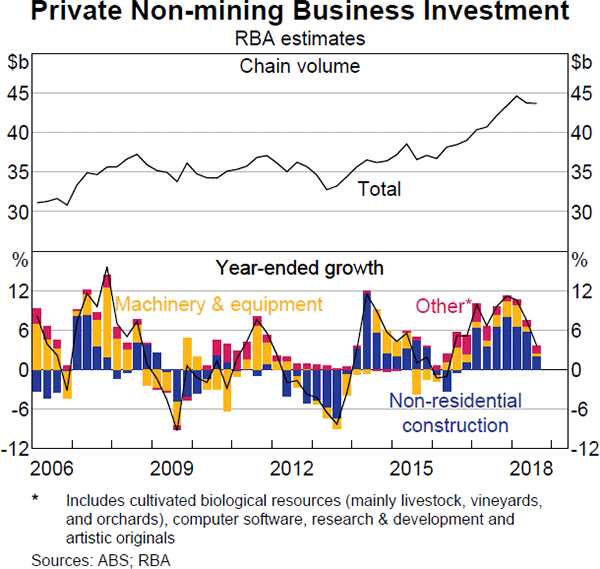
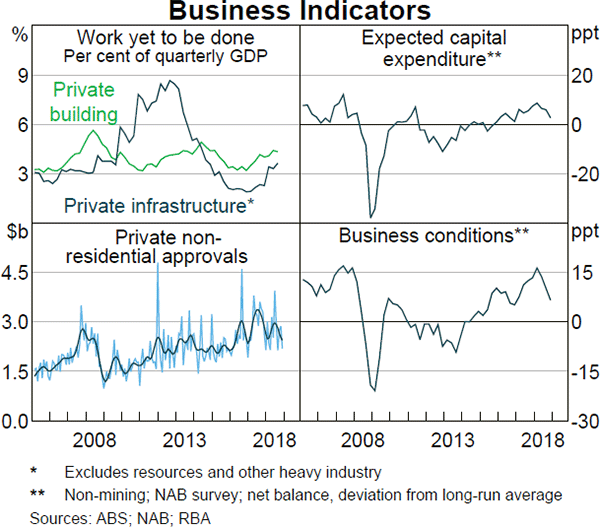
Investment intentions for 2018/19 reported by firms in the Australian Bureau of Statistics (ABS) Capital Expenditure (Capex) survey were revised higher in the most recent survey and point to solid growth in buildings & structures investment (Graph 2.4). By industry, the largest contribution to the upgrade in expectations came from the transport sector. Survey indicators of business conditions have declined from the very high levels seen in the first half of 2018 to be closer to their long-run average.
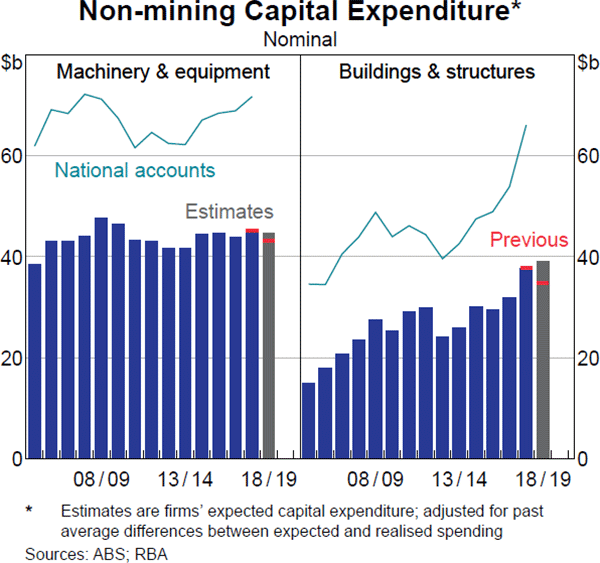
The long decline in mining investment is almost complete
Mining investment declined sharply in the September quarter as construction on the remaining liquefied natural gas (LNG) projects continued to wind down (Graph 2.5). There may be some further declines in mining investment over the remainder of 2018/19, but they are likely to be smaller than those seen in recent quarters. The Capex survey, information from the Bank's liaison program and company announcements indicate that mining firms have been increasing spending on machinery & equipment over the past year and further growth is anticipated.
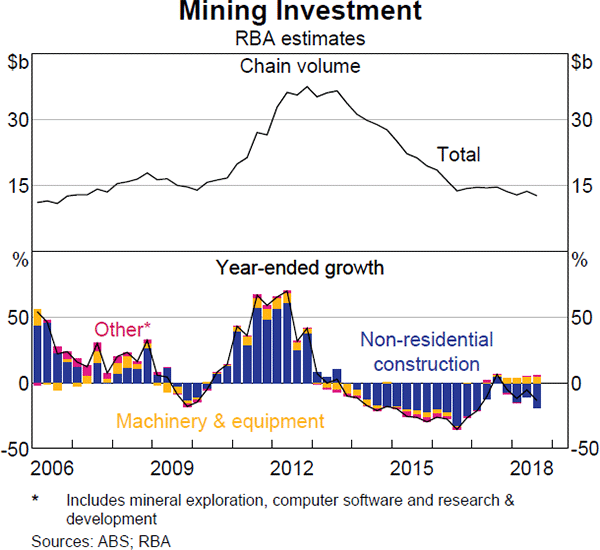
Alongside slower growth in investment, imports contracted in the September quarter after several quarters of sustained growth (Graph 2.6). Available indicators suggest that there was modest growth in imports in the December quarter.
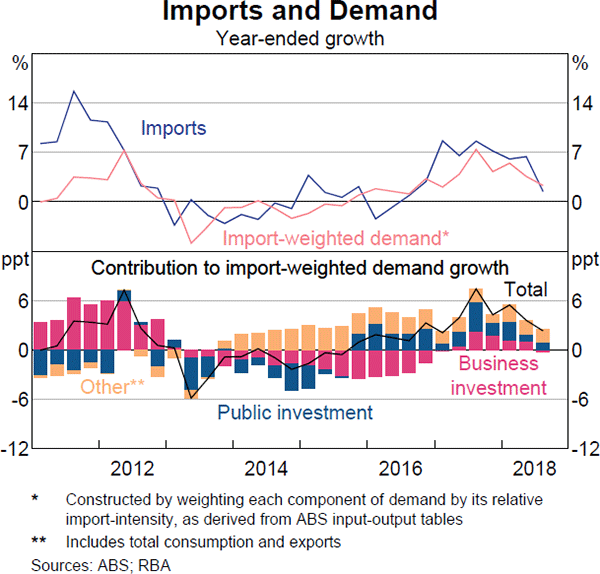
Public demand remains strong
Public demand grew by 1.4 per cent in the September quarter, and by 4.5 per cent in year-ended terms. Public investment grew at a strong pace in the quarter and the large pipeline of projects is expected to continue to support public investment over coming years. Public consumption growth has eased over recent quarters, but remains close to 5 per cent in year-ended terms. Updates to state and federal budgets indicate that consolidated government underlying deficits in 2017/18 and 2018/19 will be around 0.5 per cent of GDP smaller than previously projected, supported by stronger federal revenues (Graph 2.7).
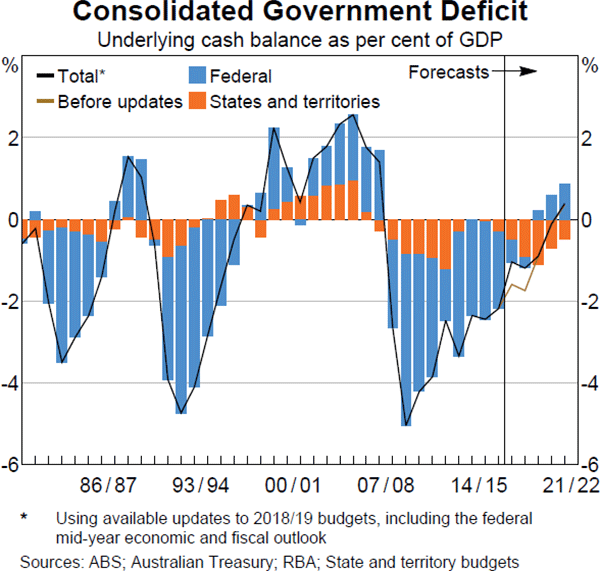
Drought continues to weigh on rural activity and exports
Drought conditions have affected large parts of south-eastern Australia over the past year or so, although some of the affected regions have benefited from rainfall in recent months. The dry conditions have weighed on some types of rural production and have contributed to higher farm input costs. Consistent with this, and partly reflecting a return to lower output levels after a record harvest in 2016/17, farm GDP and rural exports fell by almost 10 per cent over the year to the September quarter, subtracting ¼ of a percentage point from year-ended GDP growth.
Rural exports increased a little in the September quarter in part because strong overseas demand and drought-related destocking supported meat exports (Graph 2.8). But as livestock numbers fall, this support for meat production will diminish. Together with lower crop production, this is expected to see rural output fall further in coming quarters, with continued dry weather forecast for some regions.
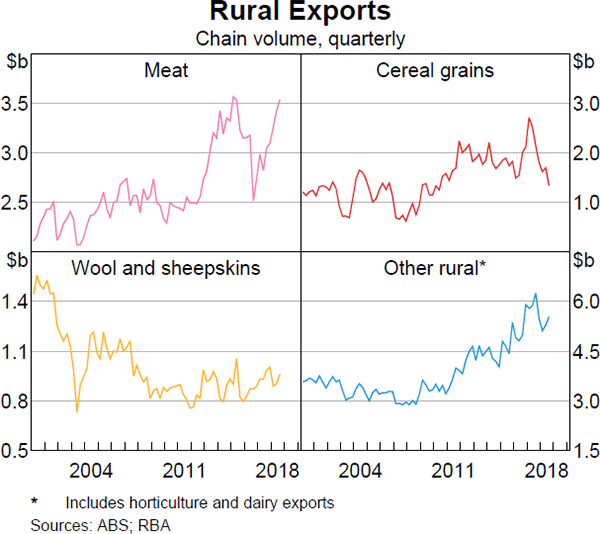
Other non-resource exports have continued to grow
Service and manufactured exports have grown steadily over recent years, supported by the continued economic expansion in Australia's major trading partners. Service exports are expected to remain a significant contributor to export growth over the next couple of years. In particular, rising enrolments of overseas students in Australia are expected to support education exports.
LNG exports continued to grow strongly in the September quarter, though resource exports declined overall, driven by iron ore and coal, which were affected by supply disruptions (Graph 2.9). Resource export volumes are expected to have declined again in the December quarter. Although there have been some reports of tighter coal import restrictions in China, which accounts for almost one-quarter of Australia's coal exports, information from the Bank's liaison program suggests that coal demand from other markets remains favourable. Iron ore exports are expected to have declined a little in the December quarter, partly due to further supply disruptions.
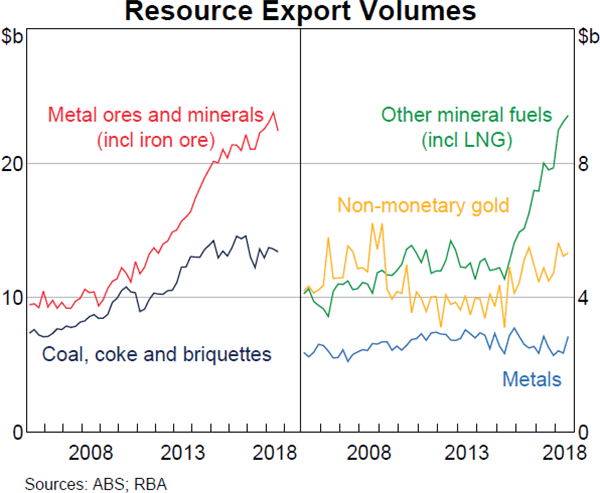
Increases in resource exports are expected over the next year as production from the final LNG projects in Western Australia continues ramping up. Other resource commodities are also expected to contribute modestly to GDP growth over the coming year, supported by productivity improvements and mine expansions from Australia's major producers.
The increase in export volumes, together with higher export prices, increased the trade surplus in the September quarter (Graph 2.10). The increase has offset some recent widening in the net income deficit, keeping the current account deficit at relatively low levels. The widening in the net income deficit over the past couple of years is consistent with a pick-up in dividend payments to non-residents because revenues in the largely foreign-owned mining sector have increased. Available data suggest another sizeable trade surplus in the December quarter.
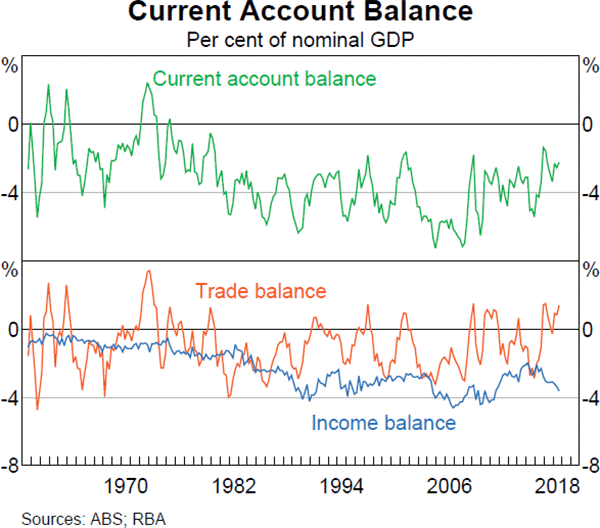
Household consumption growth has been weaker than earlier reported
Household consumption growth was 0.3 per cent in the September quarter and eased to 2.5 per cent in year-ended terms (Graph 2.11). Sizeable revisions to consumption growth in both directions in recent national accounts have made it hard to gauge underlying momentum. In the latest release, consumption growth was revised lower in most quarters over recent years, mainly due to lower spending on items such as finance & insurance and recreation & cultural services. Growth in goods consumption, which is measured with more timely data and is less prone to revisions, remained robust at 3¼ per cent over the year to September (Graph 2.12). By state, consumption growth continues to be strongest in Victoria, supported by strong population growth. Consumption growth in Western Australia has been weak for a few years, which has weighed on national growth.
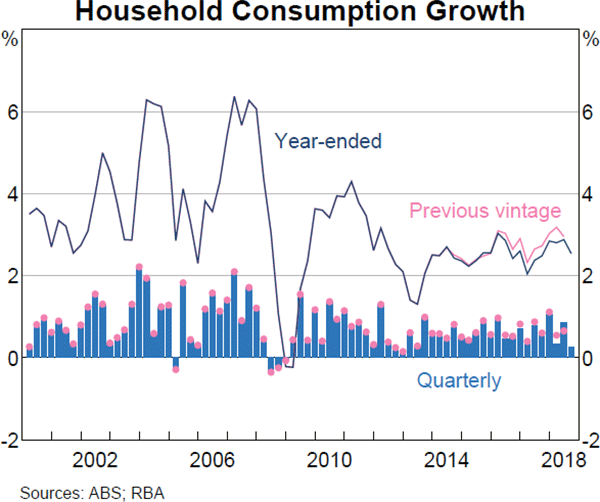
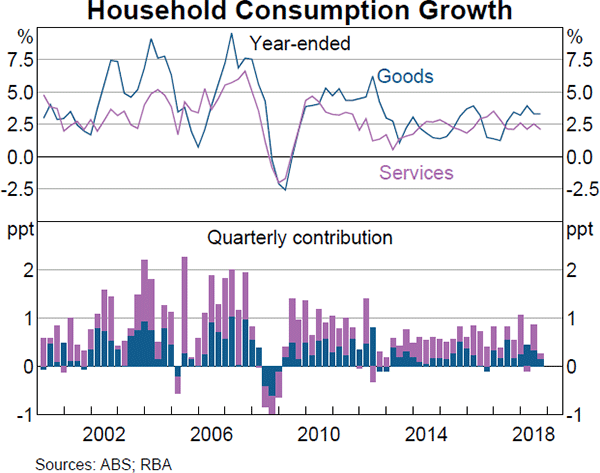
Timely indicators of household consumption have been subdued in recent months. Retail sales volumes grew by 0.1 per cent in the December quarter, weighed down by weakness in New South Wales and sales of household goods. Retailers in the Bank's liaison program judged that underlying sales growth had slowed a little in recent months, and that the timing of sales had shifted with ‘Black Friday’ and post-Christmas discounting. Online retail sales growth remains strong, however, sales of new motor vehicles to households declined by 3 per cent in the three months to January (although they account for only 2 per cent of consumption). Household sentiment towards their own finances has remained around average.
Household income growth has remained low despite strong employment growth
Growth in household income remains below its long-run average. Growth in disposable income in the September quarter was 0.3 per cent. In year-ended terms, growth in labour income remains stronger than in recent years, mostly reflecting increases in employment (Graph 2.13). However, measured non-labour income growth has been relatively weak; social assistance payments have not grown for around four years and income from unincorporated businesses declined in the September quarter. Notwithstanding slow growth of household incomes in gross terms, strong growth in tax payments has also contributed to the low growth in household disposable income.
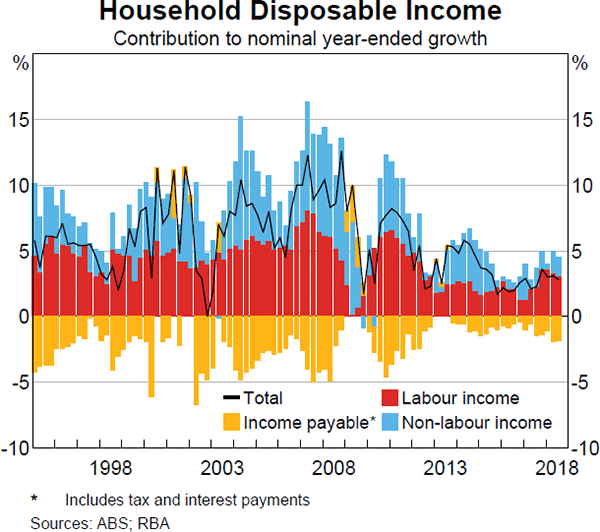
The outlook for household spending is a key source of uncertainty
The prospect of continued low growth in household disposable income remains a key risk to the outlook for household consumption, especially given high levels of household debt and the recent declines in housing prices. Despite the recent downward revisions, consumption growth has in recent years been relatively resilient to weak income growth and has outpaced income growth (Graph 2.14). This has implied a decline in the rate of household saving. As discussed in the ‘Domestic Financial Conditions’ chapter, growth in household credit has slowed in recent months and the ratio of household debt to income is estimated to have been broadly stable at a relatively high level in the September quarter. Recent asset price movements mean that net household wealth is likely to have declined in the December quarter, following several years of strong growth (Graph 2.15).
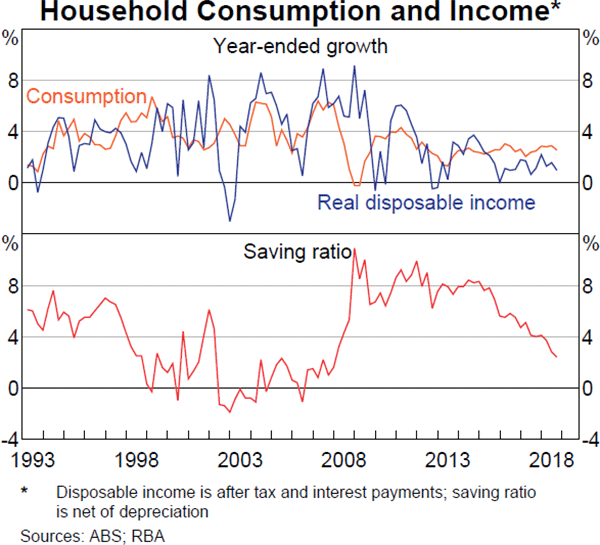
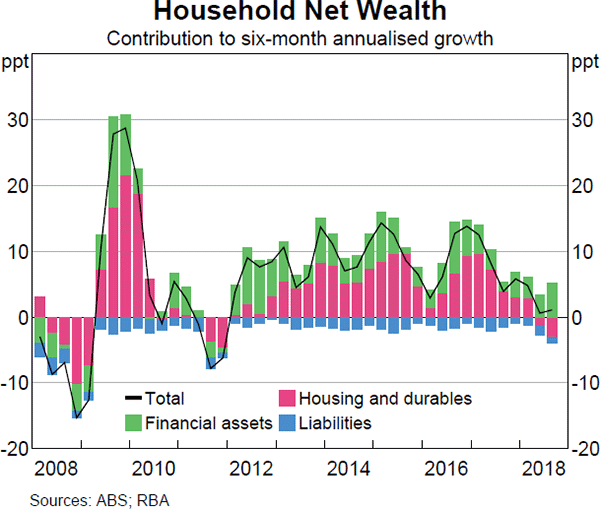
Housing prices have declined further in some cities
Conditions in a number of housing markets weakened further since the previous Statement, particularly in Sydney and Melbourne. In these cities, housing prices have declined by around 4 per cent since the previous Statement, (Graph 2.16; Table 2.2), with falls across detached housing, apartments, and different price segments. Notwithstanding recent declines, housing prices in Sydney and Melbourne remain considerably higher than five years ago. Housing prices have also fallen further in Perth and Darwin, where they have now retraced to levels of around a decade ago. In most other capital cities housing price growth has remained subdued, though, in Hobart, housing prices increased by 9 per cent over 2018.
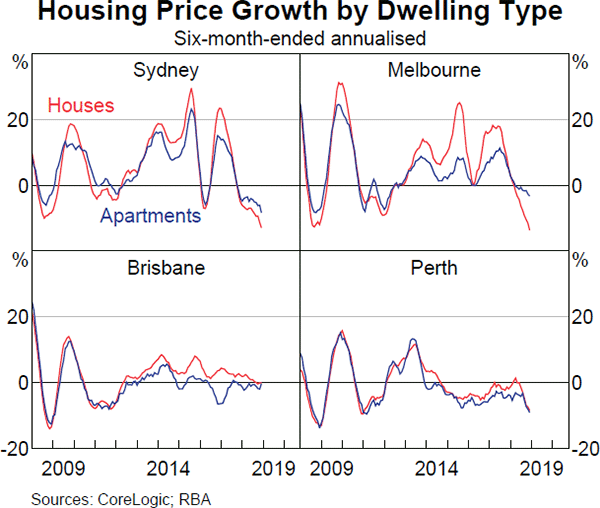
Non-price indicators, such as vendor discounts and days on the market, also suggest housing market conditions have deteriorated in Sydney and Melbourne in recent months. Housing turnover continues to decline in these cities, and auction clearance rates remain low (Graph 2.17).
The declines in housing prices reflect changes in both demand and supply. Demand has softened in response to the prior years of strong price growth and reduced interest from foreign buyers. As prices have declined, sentiment towards the housing market has become more cautious, especially among investors in the Sydney and Melbourne markets. The shift in tone has been reflected in a slowing in demand for housing finance at the same time as lenders have tightened credit supply in response to regulatory actions (see ‘Domestic Financial Conditions’ chapter). A large supply of new dwellings in some cities has also placed downward pressure on housing price growth and rents. In general, supply has been concentrated in cities where there has been relatively strong population growth, which should continue to support the underlying demand for new dwellings.
| January Three-month-ended | January Year-ended | January Fall since peak | January Growth since 2013 | |
|---|---|---|---|---|
| Sydney | −4.5 | −9.7 | −12 | 48 |
| Melbourne | −4.0 | −8.3 | −9 | 43 |
| Brisbane | −0.4 | 0.0 | −1 | 18 |
| Perth | −2.7 | −5.6 | −17 | −10 |
| Adelaide | −0.1 | 0.9 | na | 19 |
| Canberra | 0.8 | 3.8 | na | 23 |
| Hobart | 1.0 | 7.4 | na | 41 |
| Darwin | −2.8 | −3.5 | −26 | −24 |
| Australia(a) | −3.3 | −6.9 | −8 | 33 |
|
(a) Based on capital cities Sources: CoreLogic; RBA |
||||
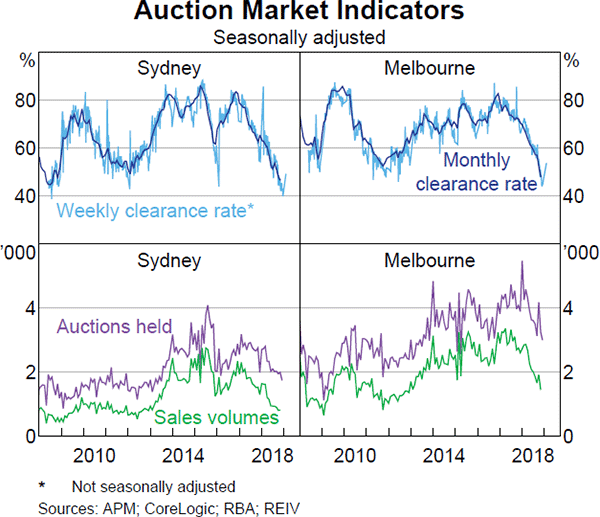
In the rental market, the national vacancy rate is a little below average (Graph 2.18). This partly reflects the low vacancy rate in Melbourne as population growth continues to absorb the supply of new dwellings. In contrast, the vacancy rate in Sydney has risen, particularly in the middle-ring suburbs as new supply has come online; advertised rent inflation has declined. In other capital cities, rental vacancy rates have fallen and advertised rents have generally risen.
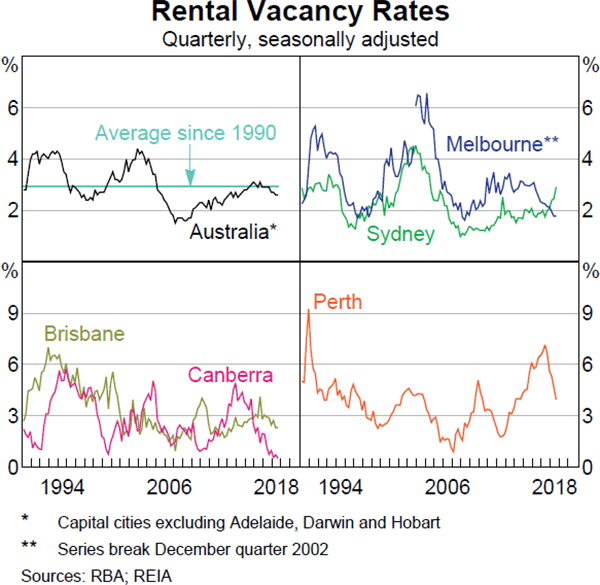
Dwelling investment is close to its peak
Dwelling investment rose by 1 per cent in the September quarter. Strong growth in alterations and additions investment more than offset small declines in investment in both new detached and higher-density dwellings across most states (Graph 2.19). A range of indicators suggest dwelling investment is around its peak for the cycle. The pipeline of work to be done remains very large, which should continue to support a high level of dwelling investment in the near term (Graph 2.20). However, the number of building approvals has been trending lower for more than a year to be around its lowest level since 2013. Information from the Bank's liaison program also points to a slowing in the earlier stages of residential development over the past year. In particular, demand for new, off-the-plan apartments in Sydney and Melbourne has declined, driven by weaker demand from domestic investors and foreign buyers. Greenfield land sales have also fallen over the past year. Many property developers cite tighter access to credit as a dampening factor.
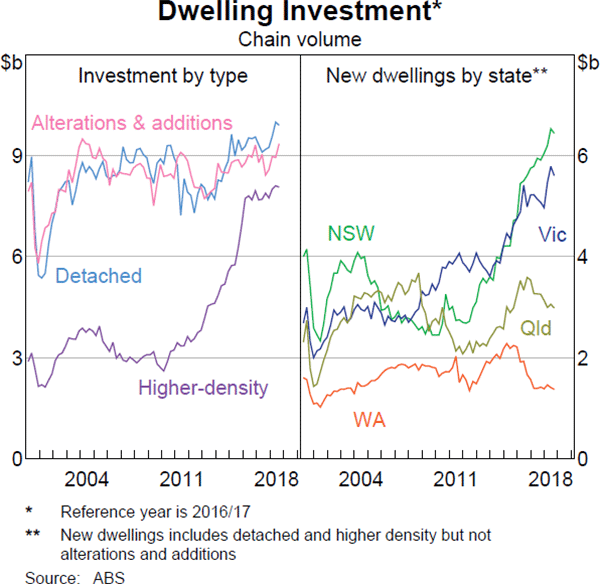
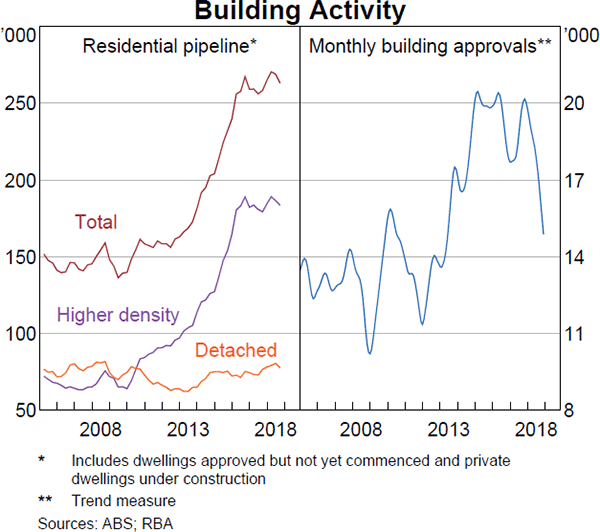
Employment growth remains strong
Employment increased by a further 80,000 in the December quarter to be 2¼ per cent higher over the year. This increase was stronger than growth in the working-age population and, as a result, the ratio of employment to the working-age population has risen to its highest level since early 2011 (Graph 2.21). Full-time employment has accounted for most of the employment growth over the past two years, though in the final two months of the year the growth was all in part-time employment. Full-time employment growth is often relatively strong during periods of improvement in the labour market.
Labour market conditions have continued to strengthen in Victoria and New South Wales over the December quarter. Employment has increased to an historically high share of the working-age population in both states, even though population growth has been strong relative to history (Graph 2.22). Employment in the other states has been little changed in recent months, and declined slightly as a share of the respective states' populations. In Western Australia, there has been moderate employment growth over the past year at the same time as a modest increase in population growth.
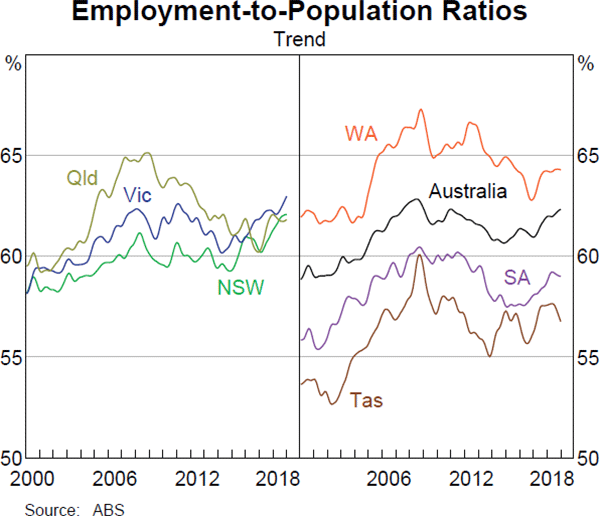
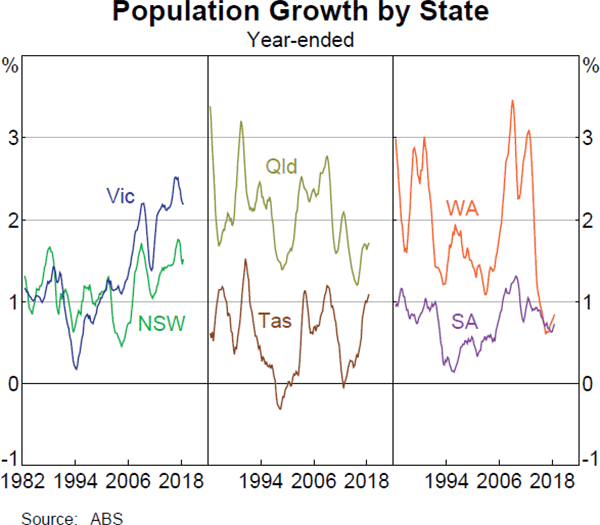
Employment growth was concentrated in four industries over the year to September 2018: education; health care & social assistance; construction; and professional, scientific, & technical services (Graph 2.23). Growth in employment in education and health care & social assistance reflects the longer-run trend towards stronger demand for these services, including from overseas students. Construction employment growth has been driven by demand from residential and public infrastructure building activity. In this Statement, we have shifted to discussing industry employment trends based on the ABS' new Labour Account publication (see ‘Box C: New Industry Employment Estimates’).
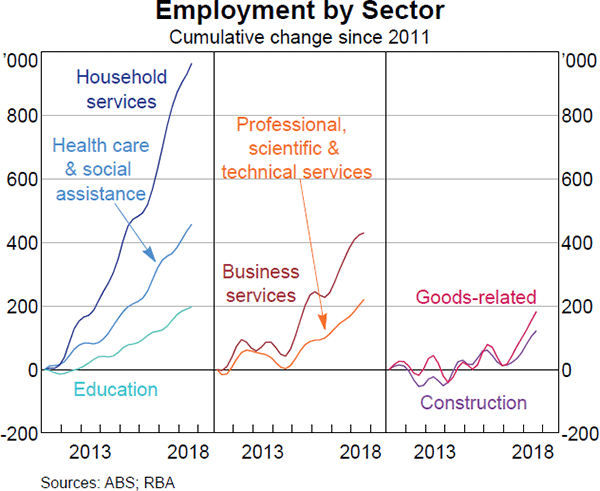
The unemployment rate has declined, but some spare capacity remains
The unemployment rate was 5 per cent in the December quarter, having declined by half a percentage point over 2018 (Graph 2.24). Taking a longer perspective, the unemployment rate has declined gradually over the past four years and is now at its lowest level since mid 2011. Over recent years, the unemployment rate has moved closer to conventional estimates of full employment. However, the labour market could still have some capacity to absorb additional labour demand before anything more than gradual upward pressure is generated for wage and price inflation.
A broader measure of labour market underutilisation – which captures the additional hours that underemployed people would like to work as well as hours sought by the unemployed – has also declined further over the past few years. This has mostly been driven by the decline in unemployment, although the underemployment rate has also declined a little over the past two years. At the same time there has been a notable increase in the net flow of workers from part-time to full-time jobs, which had been below average for a number of years.
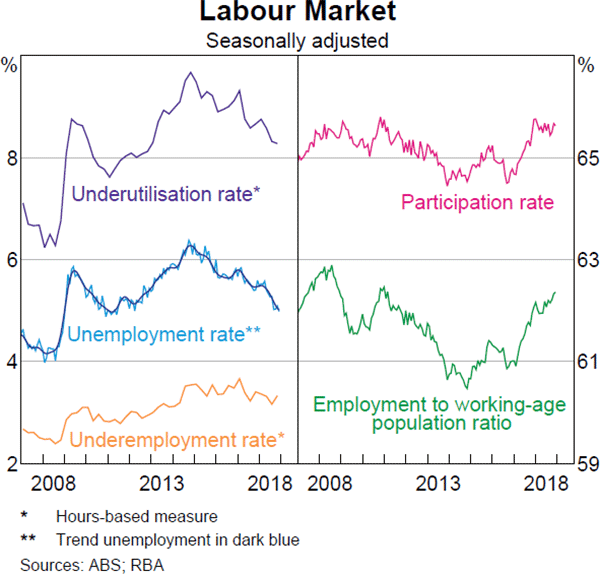
The labour force participation rate remained around record highs in the latter months of 2018. The participation rates of both sexes across most broad age categories have been little changed or declined a little this year (Graph 2.25). One exception is those over the age of 65, especially males, who have recorded a further increase in participation; this is likely to be related, at least in part, to the increase in the age of pension eligibility to 65½ years in mid 2017.
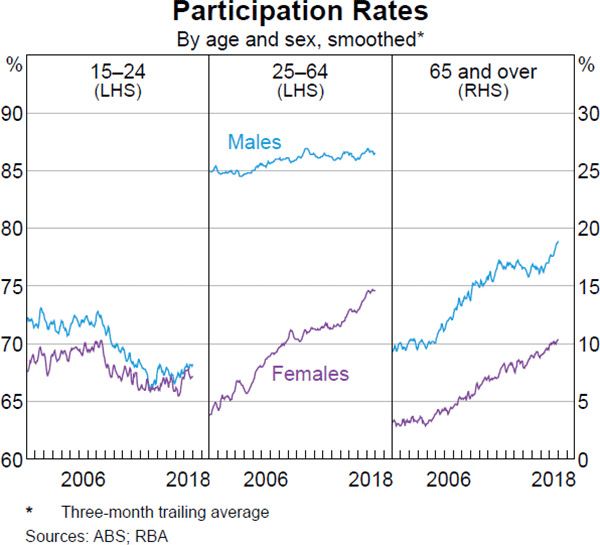
Leading indicators of labour market conditions remain positive
Labour demand indicators suggest that growth in labour demand will remain slightly above average in early 2019 (Graph 2.26). Job vacancies remained at a high level as a share of the labour force in November, though growth in vacancies had slowed since earlier in 2018. While measures of the number of job advertisements have stabilised or declined a little over the past year or so, business' employment intentions remain strong according to the NAB survey and the Bank's liaison program.
